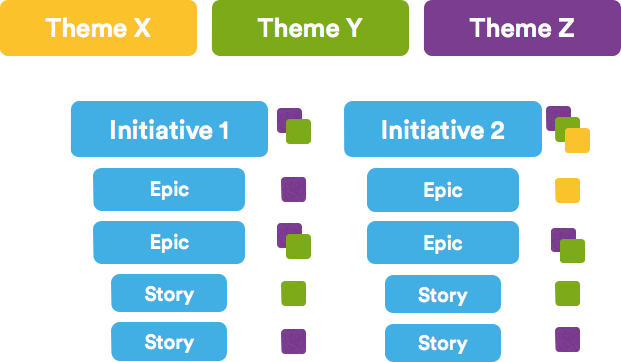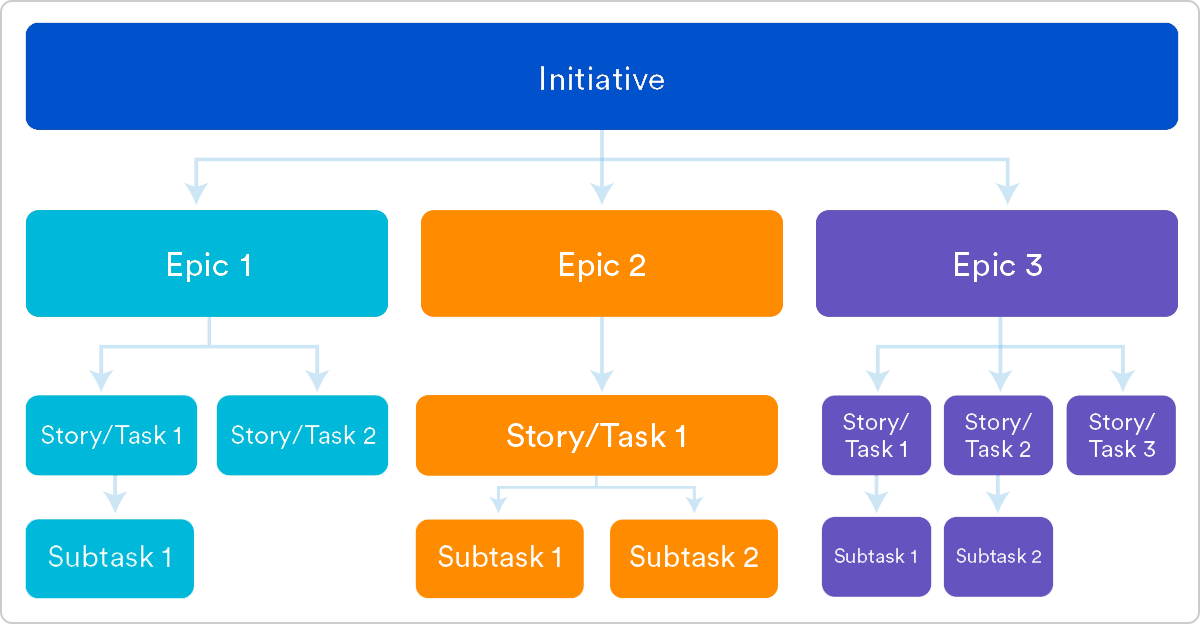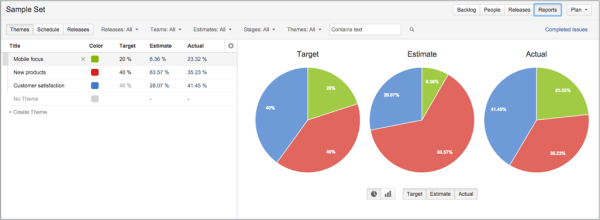Let’s say you and your team want to do something ambitious, like launch a rocket into space. To do so, you’ll need to structure your work: from the largest objectives down to the minute details. You’ll want to be able to respond to change, report your progress, and stick to a plan. Epics, stories, themes, and initiatives are precisely the tools you’ll need to do so.
By understanding how these popular agile methodologies help organize work, your team can strike a healthy balance between structure, flexibility, and launching rockets into space.
What are stories, epics, initiatives, and themes?
- Stories, also called “user stories,” are short requirements or requests written from the perspective of an end user.
- Epics are large bodies of work that can be broken down into a number of smaller tasks (called stories).
- Initiatives are collections of epics that drive toward a common goal.
- Themes are large focus areas that span the organization.

Agile Epic vs Story
In a sense, stories and epics in agile are similar to stories and epics in film or literature. A story is one simple narrative; a series of related and interdependent stories makes up an epic. The same is true for your work management, where the completion of related stories leads to the completion of an epic. The stories tell the arc of the work completed while the epic shares a high-level view of the unifying objective.
On an agile team, stories are something the team can commit to finish within a one or two-week sprint. Oftentimes, developers would work on dozens of stories a month. Epics, in contrast, are few in number and take longer to complete. Teams often have two or three epics they work to complete each quarter.
If your company was launching rockets into space, and wanted to improve the streaming service for your launches, you might structure your stories like the ones below.
Examples of an agile story:
- iPhone users need access to a vertical view of the live feed when using the mobile app.
- Desktop users need a “view fullscreen” button in the lower right hand corner of the video player.
- Android users need to be linked to apple store.
The above stories are all related, and could all be considered individual tasks that drive toward the completion of a larger body of work (an epic). In this case, the epic might be “Improve Streaming Service for Q1 Launch.”
Organizing work into stories and epics also helps you and your team communicate effectively within the organization. If you were reporting your team’s progress to the Head of Engineering, you’d be speaking in epics. If you were talking to a colleague on your development team, you’d speak at the story level.
For complete definitions, examples and best practices, see:
Agile Epic vs Initiative
In the same way that epics are made up of stories, initiatives are made up of epics. Initiatives offer another level of organization above epics. In many cases, an initiative compiles epics from multiple teams to achieve a much broader, bigger goal than any of the epics themselves. While an epic is something you might complete in a month or a quarter, initiatives are often completed in multiple quarters to a year.

Example of epics in an initiative:
Let’s say your rocket ship company wants to decrease the cost per launch by 5% this year. That’s a great fit for an initiative, as no single epic could likely achieve that big of a goal. Within that initiative, there would be epics such as, “Decrease launch-phase fuel consumption by 1%,” “Increase launches per quarter from 3 to 4,” and “Turn all thermostats down from 71 to 69 degrees #Dadmode.”
At Atlassian:
Internally, we call our Initiatives “PC Tickets.” Project Central tickets are configured in Jira Software just like our epics. Each team takes their four or five most important goals for the year and makes PC tickets for each one. These PC tickets are used by the founders and management to understand all the work being done in the company.
Initiatives vs. Themes
In many organizations the founders and management team will encourage the pursuit of some aspirational destination. These are the (sometimes super corny) goals announced each year or quarter, and themes are how you keep track of them.
- Initiatives are collections of epics
- Themes are labels that track high-level organizational goals
Initiatives have a structural design. They house epics, and the completion of those epics will lead to the completion of the initiative. Themes are an organizational tool that allows you to label backlog items, epics, and initiatives to understand what work contributes to what organizational goals. Themes should inspire the creation of epics and initiatives but don’t have a ridgid 1-to-1 relationship with them. A theme for a rocket ship company would be something like “Safety First.”
This is what themes look like in Portfolio for Jira:

At Atlassian:
One of our themes this year is Open Work. This is a push towards greater transparency, inside and outside of the company. My team is working towards this theme by doing a public retrospective on agile. We’re asking software developers to reflect on their agile development experience and tweet feedback with #RetroOnAgile. As a three month campaign, we’ve built an epic for this, and have labeled the epic with the Open Work theme.
Structuring your work:
Being agile and embracing structure are not mutually exclusive, and the structure laid out here is not one size fits all. Success is when you and your team understand these concepts and adapt them to your needs. For us, that's stories, epics, initatives, and themes. You can get started by learning how to set up Epics in Jira Software.
No comments:
Post a Comment